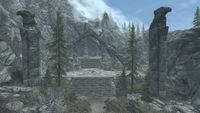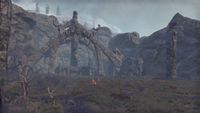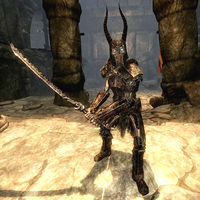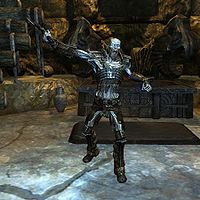Lore:Ragnvald
| Ragnvald | |
|---|---|
| Type | Nordic Ruin |
| Continent | Tamriel |
| Province | Skyrim |
| Hold | The Reach |
| Appears in | Skyrim, ESO |

Ragnvald is an ancient Nordic barrow found in the mountains of the Reach, within the province of Skyrim. Built in the hidden slopes of the Druadach Mountains, the temple is the burial place of their forlorn Dragon Priest, Otar the Mad.[1]
History[edit]
Ragnvald was active in the Merethic Era, concurrent with the reign of the Dragon Cult,[2] and at the helm of its priesthood was Otar the Mad. Eventually, Otar's time had passed and he was sealed away in his sarcophagus for eternity. The only way to activate it was with the twin skull keys of its guardians, the warriors, Saerek and Torsten. They were then sealed away in two separate parts of the temple, one in the crypts and the other in the canalways. Since then, the ruins were abandoned.[1][nb 1]
During the Interregnum, the Icereach Coven of witches constructed a ritual site on the vast courtyard of Ragnvald and activated a harrowstorm with help from relics supplied by the Gray Host. However the ritual was disrupted by several warriors in the area.[3]
During the Skyrim Civil War in 4E 201, the ruins of Ragnvald were still abandoned but the Draugr were roaming its halls. An adventurer delved deep into the tomb and uncovered Otar's tomb. From then on, they searched across the ancient monastery for the skull keys and defeated both Saerek and Torsten. In the end, they inadvertently resurrected Otar the Mad and engaged in combat until the priest was destroyed. The adventurer left Ragnvald with the malachite mask of Otar.[4]
Gallery[edit]
See Also[edit]
- For game-specific information, see the Skyrim and Elder Scrolls Online
 articles.
articles.
Notes[edit]
References[edit]
- ^ a b Ragnvald in Skyrim
- ^ The Dragon War — Torhal Bjorik
- ^ Ragnvald Ritual Site in ESO: Markarth
- ^ Ragnvald quest in Skyrim



